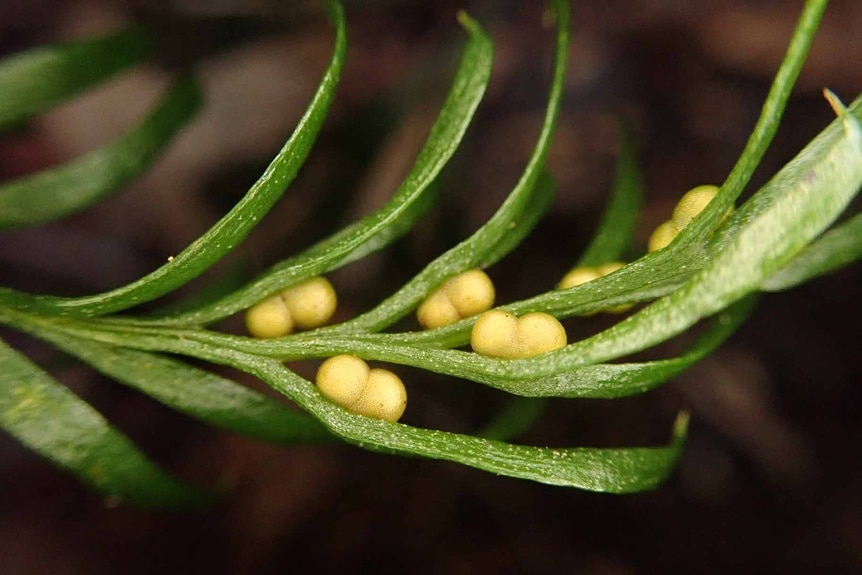Create a free profile to get unlimited access to exclusive videos, sweepstakes, and more!
This Tiny Island Fern Has the Largest Known Genome with 50 Times More DNA Than Humans
It's not always about the size of the genome.
One of the most enduring scenes from Jurassic Park (streaming now on Peacock) is toward the beginning, when Doctors Sattler (Laura Dern), Grant (Sam Neill), and Malcolm (Jeff Goldblum) have just arrived at the park. They settle in for a theme-park-style tour complete with an animated introduction to the art of genetic resurrection. An anthropomorphized double helix called Mr. DNA explains how ancient mosquitos sucked up dinosaur blood before being trapped in amber. Millions of years later, scientists retrieved that DNA, filled it in with some frog DNA, and the rest is cinematic history.
Figuring out the right genetic code for a dinosaur is no easy task, Mr. DNA explains. Each species comes with a recipe millions of letters long and some of those recipes are more complicated than others. There’s a sort of natural assumption that the more complex an organism is, the more complex its genome should be, but that isn’t always true.
It makes a certain amount of intuitive sense that the recipe for a complex organism would be longer than the recipe for something simpler. If pressed, most of us would probably guess that the genome for something like a dog is larger than something like an ant, that a mosquito’s genome is larger than that of a bacterium, and that the human genome is larger than the genome of a plant. It turns out that in biology, as in cooking, sometimes the most unassuming things on the table are the hardest to pull off. Which is why, despite all of our intuitions, scientists recently identified the largest genome ever discovered, in a small island fern.
For More on DNA
Can We Save Living Species by Recovering Extinct Genomes from Dire Wolves and Giant Sloths?
Fighting Dengue Fever with Genetically Modified Mosquitos
Remember That Half-Eaten Great White Shark? DNA Evidence Identifies the Killer (Whale)
A Tiny Fern with the World’s Largest Genome
The current record holder for world’s largest genome is a small New Caledonian fork fern called Tmesipteris oblanceolata. It grows only a few inches tall and exists only on Grande Terre, a small island east of Australia.
We’ve known for a while that some seemingly simple plants and animals have much larger genomes than we do. Scientists can determine the size of a genome by calculating the molecular weight of the DNA molecule, which is how they found out that onions have about five times as much DNA as humans for no obvious reason. The disparity is so notable that it inspired what’s known as the “onion test,” which suggests that any attempt to explain junk DNA (more on that in a minute) must be able to explain why onions need five times more DNA to facilitate that function than we do.
In 2010, botanist Jaume Pellicer and colleagues published the discovery of an exceptionally large genome in the plant Paris japonica, a fern which grows near Nagana, Japan. Pellicer knew there were related species growing on nearby islands in the Pacific, with potentially even larger genomes, but it took years to find one. In 2023, they finally collected specimens of Tmesipteris oblanceolata from Grande Terre and got them back to the lab. After mincing the leaves, isolating the DNA, and getting it onto the microscopic scale, Pellicer and team confirmed a genome 50 times the size of the human genome, larger than any other known organism. The discovery was published in the journal iScience.
Why Some Organisms Have Surprisingly Massive Genomes
When we look at DNA, we find genes made out of four bases: adenine (A), cytosine (C), guanine (G), and thymine (T). Those letters are laid out in a long string, two of them actually, bound together in a spiral called a double helix, and the whole thing is snuggled up nice and tight inside the nucleus of your cells.
The order of bases in your DNA serves as the recipe, literally spelling out how to build your body one protein at a time. The trouble is that the recipe (the genome) is inside the nucleus, while the line cook (the ribosome) is outside of the nucleus in the cytoplasm. There’s no way to get the DNA out or the ribosome in, so the nucleus makes RNA copies of certain parts of your DNA and passes those through tiny gates, out into the cytoplasm. The ribosome grabs onto them, reads the recipe, and uses them to build proteins, which your body uses to do pretty much everything.
But the nucleus only copies and sends out a small portion of the DNA, known as coding DNA. It’s the parts of your genome which are responsible for actually doing things in your body. Another small portion of your genome is noncoding but it facilitates other functions, like telling genes when to turn on and off or changing the way they are expressed. Most of a genome is noncoding, has no discernible purpose, and is commonly called junk DNA.
Biologists think we pick up junk DNA in a number of ways. Sometimes when a gene gets copied, there is an error in the copying process and the new gene doesn’t work. As long as it’s not detrimental, it hangs around as a non-coding part of the genome. Other times we pick up bits of DNA from invading viral infections and they stick around too. The process of natural selection doesn’t care about being the best, it only cares about being good enough to survive. You don’t have to win, you just can’t lose, and it seems like you can keep running the evolutionary race with a whole bunch of genetic baggage on your back. A 2017 study found that the genomes of most species are made of only about 10% - 15% functional DNA.
With so much room for genetic stowaways, the complexity of an organism has a much smaller impact on the size of its overall genome than the amount of junk it has accumulated. You can be a 3-inch fern and still have the biggest genome on the block. There’s probably a limit to how large a genome can be – there is a cost to copying and caring around a bunch of biological baggage – but we haven’t found it yet. Researchers suspect there are even larger genomes waiting out there to be found.
Get in on the genetic tomfoolery with Jurassic Park, streaming now on Peacock.
































